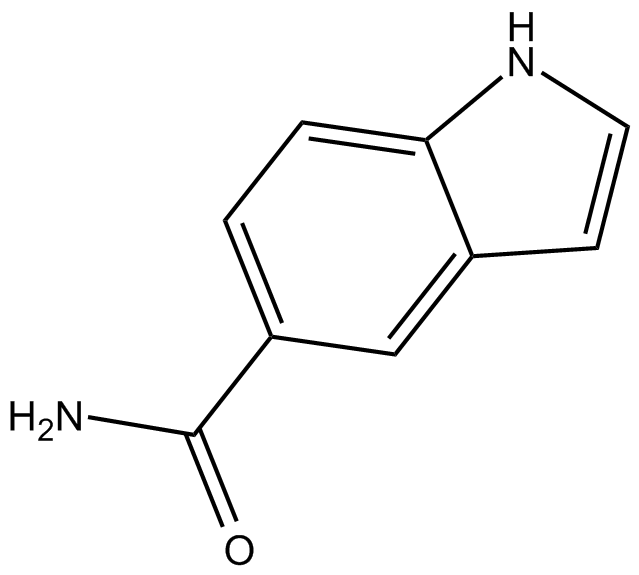SD 169 (Synonyms: 5-Carbamoylindole) |
| Catalog No.GC14982 |
selective ATP competitive inhibitor of the MAP kinases p38α and p38β
Products are for research use only. Not for human use. We do not sell to patients.

Cas No.: 1670-87-7
Sample solution is provided at 25 µL, 10mM.
SD 169 (indole-5-carboxamide) is a selective and ATP competitive inhibitor of the MAP kinases p38α and p38β [1].
The p38 mitogen-activated protein kinases are a class of mitogen-activated protein kinases (MAPKs) that are responsive to stress stimuli, such as cytokines, ultraviolet irradiation, heat shock, and osmotic shock, and are involved in regulating inflammatory cytokine production, modulating T cell function and cell differentiation, apoptosis and autophagy [1].
SD-169 significantly reduced p38 and HSP60 expression in T cells of the pancreatic beta islets. SD-169 treatment significantly lowered the incidence of diabetes as determined by blood glucose levels. In NOD mice, SD-169 treatment significantly reduced immuno-histochemistry of pancreatic beta islet tissue in CD5+ T cell infiltration. In mildly and moderately hyperglycemic NOD mice, SD-169 (600 mg/kg) treatment lowered blood glucose and improved glucose homeostasis. SD-169 prevented the development and progression of diabetes in NOD mice by inhibiting T cell infiltration and activation, thereby preserving beta cell mass via inhibition of the p38 MAPK signaling pathway. SD 169 also reduced the incidence of diabetes, lowered blood glucose, and improved glucose homeostasis [1]. Gavage administration o SD-169 (30 mg/kg) significantly increased the rate of axonal regeneration in animals with crush injury. SD-169 significantly reduced TNF-mediated primary SC death in culture experiments. SD-169 promoted axonal regeneration through interactions with SC signaling and TNF activity [2].
References:
[1] Medicherla S, Protter A A, Ma J Y, et al. Preventive and therapeutic potential of p38α-selective mitogen-activated protein kinase inhibitor in nonobese diabetic mice with Type 1 diabetes[J]. Journal of Pharmacology and Experimental Therapeutics, 2006, 318(1): 99-107.
[2] Myers R R, Sekiguchi Y, Kikuchi S, et al. Inhibition of p38 MAP kinase activity enhances axonal regeneration[J]. Experimental neurology, 2003, 184(2): 606-614.
Average Rating: 5 (Based on Reviews and 14 reference(s) in Google Scholar.)
GLPBIO products are for RESEARCH USE ONLY. Please make sure your review or question is research based.
Required fields are marked with *




















